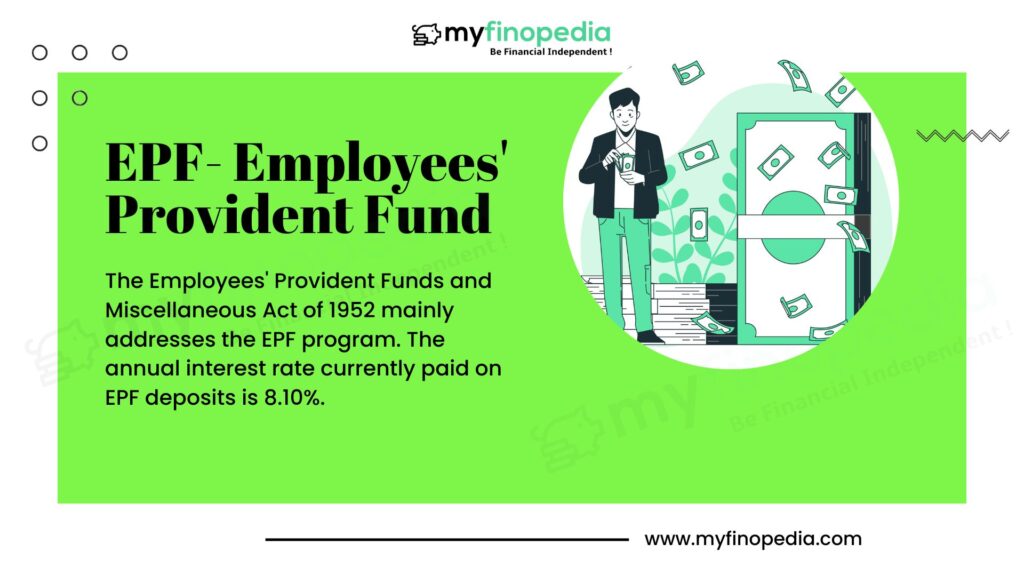At the time they leave their place of employment, employees are entitled to lump sum payments from EPFO. Under the EPF program, employees contribute a portion of their monthly salaries. It is a great platform for saving the portion of your pay that will come in handy in case of an emergency. The EPFO is responsible for overseeing the basic pension plan, the mandated provident fund, and the disability or death insurance program. EPF is in charge of more than 11 lakh crore ($157.8 billion) as of 2018. A legislative provident fund for industrial workers was strongly advised by the 1948 Indian Labour Conference. The employer deducts the employees’ EPF contributions and deposits the money in their PF accounts along with his own contribution.
Meaning:-
The Employees’ Provident Funds and Miscellaneous Act of 1952 mainly addresses the EPF program. The annual interest rate currently paid on EPF deposits is 8.10%. The organization, which was established in 1951, is governed by the Ministry of Labour and Employment of the Indian Government. Specifically, the Employees’ Provident Funds and Miscellaneous Act of 1952 addresses the EPF program.
The primary objective of this program is actually to increase your EPF balance, which is where your retirement benefits are accumulated. Essentially, this is how the scheme generates wealth. An additional component of EPS called EPS (Employee Pension Plan) aims to establish pension funds for workers over the age of 58. The EPF’s final element, the EDLI (Employee Deposit Linked Insurance Scheme), consists of a life insurance policy. It’s helpful that you don’t have to register for each of these advantages separately. Registrations for the EPF, EPS, and EDLI are all completed concurrently with EPF registration. For the 815 Commissioners, the Union Public Service Commission of India holds a direct, competitive hiring process.
If you have an Aadhaar number with you or can apply online, withdrawing EPF is now very easy and takes very little time as long as your UAN is activated and linked to your Aadhaar, PAN card, and bank information.
Features & Benefits:-
- The government-sponsored EPF program offers a guaranteed rate of return with no risk to investors.
- The government had implemented Tax Deducted at Source for PF withdrawals (TDS). TDS will be deducted from the withdrawal amount, up to a maximum of Rs 50,000, if the withdrawal occurs before the subscription period of five years has expired and a PAN Card is provided.
- If the withdrawal occurs before the subscription period of five years has expired and a PAN Card is provided, government-sponsored Tax Deducted at Source (TDS) for PF Withdrawals is a deduction from the withdrawal amount, up to a maximum of Rs 50,000. Furthermore, Section 80C tax benefits may be available for employee contributions up to Rs 1.5 lakh.
- The employee may withdraw 50% of their share of PF funds for their own or their children’s education after they have completed Grade 10 if the EPF account has been maintained for at least 7 years.
- You may withdraw up to 24 times your monthly basic salary plus DA for purchasing a plot and up to 36 times your monthly basic salary plus DA for building a house, subject to the balances in the EPF, if the EPF account is at least five years old.
- The total amount of EPF includes both employee and employer contributions as well as any accumulated interest.
- When a person leaves a job, their EPF account is given to their nominees, or if they pass away unexpectedly, to their beneficiaries.
- For paid employees in the private sector, it offers the EDLI (Employees Deposit Linked Insurance) insurance program. The VPF (Voluntary Provident Fund) is an addition to the EPF that enables subscribers to invest above the 12% cap while still receiving the same return and tax advantages.
- Employer signatures are no longer required for employee withdrawals when using a “Universal Account Number” (UAN) based Form 19.
- All EPF subscribers can check their EPF balance and make withdrawals through online access to their PF accounts. The Universal Account Number makes it easier for users to access the EPFO member portal (UAN).
- The EPFO has implemented a centralised online software that enables EPF members who are employed abroad in countries with Social Security Agreements with India to produce a Certificate of Coverage. Each EPFO member receives a 12-digit number known as the UAN (CoC).
- It helps with long-term financial planning and saving because you don’t have to invest your entire savings at once. The employee’s pay is deducted on a monthly basis, which results in sizable savings over time.
- It can help a worker in times of need financially. Additionally, it permits retirement fund savings and supports a healthy standard of living.
How does it work?
A non-constitutional organization called the Employees’ Provident Fund Organization (EPFO) promotes retirement savings among employees. Since the Employee Provident Fund is open to both employees in the public and private sectors, all employees are eligible to apply. Additionally, providing EPF benefits to employees is viewed as a requirement for any business with at least 20 employees. An employee becomes qualified to receive a variety of benefits, including pension, insurance, and EPF benefits, when they actively enroll in the program. Only employees who have not yet retired will receive this interest on their active PF accounts. However, these accounts are taxed based on an EPF employee member’s tax bracket.
The interest granted on EPF plans is calculated each month by dividing the annual rate by 12. It is simpler to ascertain the precise interest rate offered to member employees for a given month using a method like this. For instance, the monthly rate would be (8.5/12)%, or 0.7125%, if the annual interest rate was 8.5 percent. A person currently contributes 12% of their salary to their EPF account. By the end of the month, 12% of a person’s monthly salary of Rs. 15,000 would have accrued Rs. 18, which would be deposited into the person’s EPF account.
Conclusion:-
EPF contributions are eligible for tax deductions of up to Rs 1.5 lakh per year under Section 80 C of the Income Tax Act. For everyone to have income security in their later years, the Public Provident Fund (PPF) account was created specifically. In contrast, both the employer and the employee will contribute to this EPF plan. The PPF maturity amount is also exempt from taxes. Any withdrawals made within five years of the opening of the EPF account that exceed Rs 50,000 are subject to TDS. Investments in PPF accounts up to Rs 1.5 lakh per year are eligible for a tax deduction under Section 80 C of the Income Tax Act of 1961.






